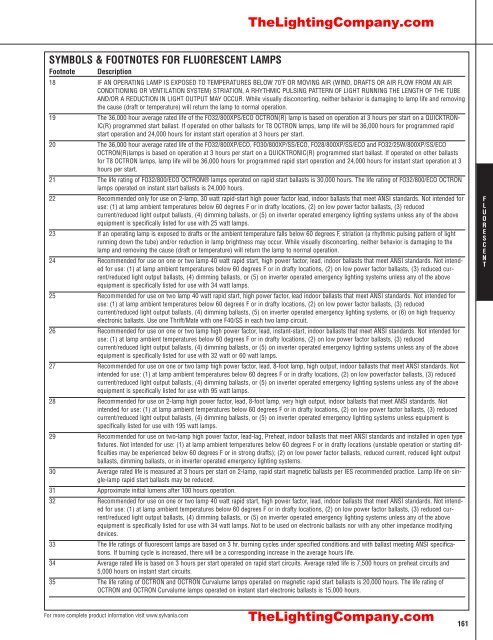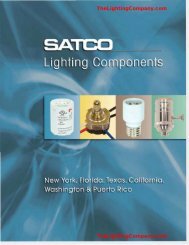Lamp and Ballast Catalog - The Lighting Company
Lamp and Ballast Catalog - The Lighting Company
Lamp and Ballast Catalog - The Lighting Company
- No tags were found...
Create successful ePaper yourself
Turn your PDF publications into a flip-book with our unique Google optimized e-Paper software.
<strong>The</strong><strong>Lighting</strong><strong>Company</strong>.com<br />
SYMBOLS & FOOTNOTES FOR FLUORESCENT LAMPS<br />
Footnote Description<br />
18 IF AN OPERATING LAMP IS EXPOSED TO TEMPERATURES BELOW 70˚F OR MOVING AIR (WIND, DRAFTS OR AIR FLOW FROM AN AIR<br />
CONDITIONING OR VENTILATION SYSTEM) STRIATION, A RHYTHMIC PULSING PATTERN OF LIGHT RUNNING THE LENGTH OF THE TUBE<br />
AND/OR A REDUCTION IN LIGHT OUTPUT MAY OCCUR. While visually disconcerting, neither behavior is damaging to lamp life <strong>and</strong> removing<br />
the cause (draft or temperature) will return the lamp to normal operation.<br />
19 <strong>The</strong> 36,000 hour average rated life of the FO32/800XPS/ECO OCTRON(R) lamp is based on operation at 3 hours per start on a QUICKTRON-<br />
IC(R) programmed start ballast. If operated on other ballasts for T8 OCTRON lamps, lamp life will be 36,000 hours for programmed rapid<br />
start operation <strong>and</strong> 24,000 hours for instant start operation at 3 hours per start.<br />
20 <strong>The</strong> 36,000 hour average rated life of the FO32/800XP/ECO, FO30/800XP/SS/ECO, FO28/800XP/SS/ECO <strong>and</strong> FO32/25W/800XP/SS/ECO<br />
OCTRON(R)lamps is based on operation at 3 hours per start on a QUICKTRONIC(R) programmed start ballast. If operated on other ballasts<br />
for T8 OCTRON lamps, lamp life will be 36,000 hours for programmed rapid start operation <strong>and</strong> 24,000 hours for instant start operation at 3<br />
hours per start.<br />
21 <strong>The</strong> life rating of FO32/800/ECO OCTRON® lamps operated on rapid start ballasts is 30,000 hours. <strong>The</strong> life rating of FO32/800/ECO OCTRON<br />
lamps operated on instant start ballasts is 24,000 hours.<br />
22 Recommended only for use on 2-lamp, 30 watt rapid-start high power factor lead, indoor ballasts that meet ANSI st<strong>and</strong>ards. Not intended for<br />
use: (1) at lamp ambient temperatures below 60 degrees F or in drafty locations, (2) on low power factor ballasts, (3) reduced<br />
current/reduced light output ballasts, (4) dimming ballasts, or (5) on inverter operated emergency lighting systems unless any of the above<br />
equipment is specifically listed for use with 25 watt lamps.<br />
23 If an operating lamp is exposed to drafts or the ambient temperature falls below 60 degrees F, striation (a rhythmic pulsing pattern of light<br />
running down the tube) <strong>and</strong>/or reduction in lamp brightness may occur. While visually disconcerting, neither behavior is damaging to the<br />
lamp <strong>and</strong> removing the cause (draft or temperature) will return the lamp to normal operation.<br />
24 Recommended for use on one or two lamp 40 watt rapid start, high power factor, lead, indoor ballasts that meet ANSI st<strong>and</strong>ards. Not intended<br />
for use: (1) at lamp ambient temperatures below 60 degrees F or in drafty locations, (2) on low power factor ballasts, (3) reduced current/reduced<br />
light output ballasts, (4) dimming ballasts, or (5) on inverter operated emergency lighting systems unless any of the above<br />
equipment is specifically listed for use with 34 watt lamps.<br />
25 Recommended for use on two lamp 40 watt rapid start, high power factor, lead indoor ballasts that meet ANSI st<strong>and</strong>ards. Not intended for<br />
use: (1) at lamp ambient temperatures below 60 degrees F or in drafty locations, (2) on low power factor ballasts, (3) reduced<br />
current/reduced light output ballasts, (4) dimming ballasts, (5) on inverter operated emergency lighting systems, or (6) on high frequency<br />
electronic ballasts. Use one Thrift/Mate with one F40/SS in each two lamp circuit.<br />
26 Recommended for use on one or two lamp high power factor, lead, instant-start, indoor ballasts that meet ANSI st<strong>and</strong>ards. Not intended for<br />
use: (1) at lamp ambient temperatures below 60 degrees F or in drafty locations, (2) on low power factor ballasts, (3) reduced<br />
current/reduced light output ballasts, (4) dimming ballasts, or (5) on inverter operated emergency lighting systems unless any of the above<br />
equipment is specifically listed for use with 32 watt or 60 watt lamps.<br />
27 Recommended for use on one or two lamp high power factor, lead, 8-foot lamp, high output, indoor ballasts that meet ANSI st<strong>and</strong>ards. Not<br />
intended for use: (1) at lamp ambient temperatures below 60 degrees F or in drafty locations, (2) on low powerfactor ballasts, (3) reduced<br />
current/reduced light output ballasts, (4) dimming ballasts, or (5) on inverter operated emergency lighting systems unless any of the above<br />
equipment is specifically listed for use with 95 watt lamps.<br />
28 Recommended for use on 2-lamp high power factor, lead, 8-foot lamp, very high output, indoor ballasts that meet ANSI st<strong>and</strong>ards. Not<br />
intended for use: (1) at lamp ambient temperatures below 60 degrees F or in drafty locations, (2) on low power factor ballasts, (3) reduced<br />
current/reduced light output ballasts, (4) dimming ballasts, or (5) on inverter operated emergency lighting systems unless equipment is<br />
specifically listed for use with 195 watt lamps.<br />
29 Recommended for use on two-lamp high power factor, lead-lag, Preheat, indoor ballasts that meet ANSI st<strong>and</strong>ards <strong>and</strong> installed in open type<br />
fixtures. Not intended for use: (1) at lamp ambient temperatures below 60 degrees F or in drafty locations (unstable operation or starting difficulties<br />
may be experienced below 60 degrees F or in strong drafts); (2) on low power factor ballasts, reduced current, reduced light output<br />
ballasts, dimming ballasts, or in inverter operated emergency lighting systems.<br />
30 Average rated life is measured at 3 hours per start on 2-lamp, rapid start magnetic ballasts per IES recommended practice. <strong>Lamp</strong> life on single-lamp<br />
rapid start ballasts may be reduced.<br />
31 Approximate initial lumens after 100 hours operation.<br />
32 Recommended for use on one or two lamp 40 watt rapid start, high power factor, lead, indoor ballasts that meet ANSI st<strong>and</strong>ards. Not intended<br />
for use: (1) at lamp ambient temperatures below 60 degrees F or in drafty locations, (2) on low power factor ballasts, (3) reduced current/reduced<br />
light output ballasts, (4) dimming ballasts, or (5) on inverter operated emergency lighting systems unless any of the above<br />
equipment is specifically listed for use with 34 watt lamps. Not to be used on electronic ballasts nor with any other impedance modifying<br />
devices.<br />
33 <strong>The</strong> life ratings of fluorescent lamps are based on 3 hr. burning cycles under specified conditions <strong>and</strong> with ballast meeting ANSI specifications.<br />
If burning cycle is increased, there will be a corresponding increase in the average hours life.<br />
34 Average rated life is based on 3 hours per start operated on rapid start circuits. Average rated life is 7,500 hours on preheat circuits <strong>and</strong><br />
5,000 hours on instant start circuits.<br />
35 <strong>The</strong> life rating of OCTRON <strong>and</strong> OCTRON Curvalume lamps operated on magnetic rapid start ballasts is 20,000 hours. <strong>The</strong> life rating of<br />
OCTRON <strong>and</strong> OCTRON Curvalume lamps operated on instant start electronic ballasts is 15,000 hours.<br />
F<br />
L<br />
U<br />
O<br />
R<br />
ESCE<br />
N<br />
T<br />
For more complete product information visit www.sylvania.com<br />
<strong>The</strong><strong>Lighting</strong><strong>Company</strong>.com<br />
161




